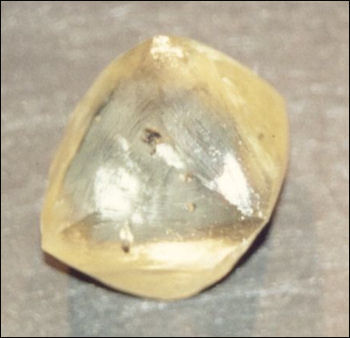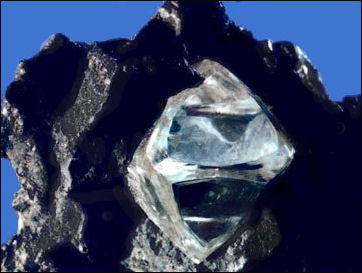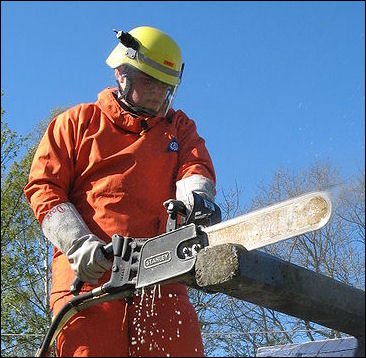RUSSIAN DIAMONDS

yellow diamond
Russia is the world’s largest or second largest diamond producer. Russian mines produce about 20 percent of the worlds diamonds, around 18 million carats annually, of which 25 to 30 percent are gems. Russia is are world's second largest producer of diamond gems after Democratic Republic of the Congo (Zaire). Most of the natural stones come from Siberia. The Russians also manufacture at least 15 million carats of synthetic diamonds
During the Soviet era, gold and diamonds were tightly controlled by the state. Even today the state is actively involved in both sectors. In 1992, Russia's Committee on Precious Metals and Gems developed a plan to escape the grip of De Beer’s—the diamond company that controlled the global market through much of the 20th century—by setting up a diamond center in the United States. According to the plan a half billion dollars of gems and precious metals was to be shipped to the United States and used as collateral to obtain a line of credit from the Bank of America. This would give them money to finance their entrance into the diamond trade.
The Soviet Union was a diamond mining giant, producing an estimated $1.5 billion in diamonds annually. The Russian government doesn't reveal how much it makes from diamond production by experts in the United States believe it brings in $4 billion a year. A diamond smuggling network operating in Angola and throughout Africa is reportedly run by a former Soviet translator.
The amount and quality of the diamonds in the Russian stockpile is a closely guarded secret. Since the quality of the leaked diamonds from Russia in 1995 was relatively low, some diamond experts believe that means the supplies are relatively low. In 1996, Yeltsin sold a large chunk of Russia’s diamond stockpile to pay for his reelection campaign.
Russian Diamond Production
Estimated diamond production in 2010 and 2011 (thousands of carats): 1) Botswana (25,000 carats in 2010 and 25,000 in 2011); 2) Russia (17,800 and 17,800); 3) Angola (12,500 and 12,500); 4) Canada (11,773 and 11,800); 5) Congo (5,500 and 5,500); 6) South Africa (3,500 and 3,500); 7) Namibia (1,200 and 1,200); 8) Guinea (550 and 550); 10) Ghana (300 and 300); 11) Central African Republic (250 and 250); 12) Sierra Leone (240 and 240); 13) Brazil (200 and 200); 14) Guyana (144 and 144); 15) China (100 and 100); 16) Australia (100 and 100): 17) Tanzania (77 and 77). [Source: geology.com, based on USGS data]
Diamond producers (mine production in carats in 1997): 1) Australia (40,200,000); 2) Russia (19,100,000); 3) Botswana (16,000,000); 4) Congo (15,000,000); 5) South Africa (10,170,00); 6) Namibia (1,500,000); 7) Angola (1,234,000); 8) China (1,130,000); 9) Brazil (900,000); 10) Ghana (700,000); 11) Central African Republic (500,000); 12) Zimbabwe (450,000); 13) Guinea (200,000); 14) Sierra Leone (200,000); 15) Liberia (150,000); 16) Venezuela (150,000); 17) Rest of the World (386,000).
Major diamond producing countries (supply in millions of carats in 1995): 1) Australia (38.5); 2) Russia (21.9); 3) Zaire (19); 4) Botswana (15.6); 5) South Africa (11); 6) Angola (4.4); 7) Brazil (2.3); 8) Ivory Coast (1.5); 9) Namibia (1.3). Major diamond producing countries (value in millions of dollars in 1995): 1) Botswana and Russia (1,300); 3) South Africa (1,200); 4) Zaire (696); 5) Angola (606); 6) Namibia (375); 7) Australia (346); 8) Brazil (120); 9) Ivory Coast (115). [Source: Terraconsult BVBA and Time magazine]
Early History of Diamond Mining in Russia

Rough diamond
The history of mining rough diamonds in Russia dates back to the 18th century, but sustained exploration began in the late 1930s. This was when Russian researcher Vladimir Sobolev published his paper on the geological similarities between South Africa and Siberia. Activity was interrupted by World War II, but resumed in the late 1940s. Geological expeditions were sent out to find rough diamond deposits around the river Vilyui, and its tributaries – the Malaya (small) Botuobia, and Bolshaya (big) Botuobia. In 1949 they found the first rough diamond in Yakutia. By 1954, the Zarnitsa pipe was discovered – the first primary diamond deposit in the Soviet Union. From that point, Russian diamonds made their way into world markets. [Source: Alrosa website]
Yakutalmaz Trust was created in 1957 in the tent village of Mirny, next to the Mir kimberlite pipe. The same year, it produced the first industrial diamonds. Two years later, it began to supply them abroad under a contract agreement with De Beers Corporation. Initially, rough diamonds were produced from the Mir kimberlite pipe and adjacent placers. Despite the challenges of working in the remote taiga – such as winter temperatures down to minus 60 degrees, no roads, and extreme distances to industrial centres – nothing stopped the early explorers. Indeed, they drove even further north.
In 1961, the Soviets began developing the Aikhal pipe – located almost at the Arctic Circle – where living and working conditions were even more severe than in Mirny. During this period, major mines were opened in Western Yakutia. Processing plants and housing settlements, roads and airports were built, and a specialized research and design institute was created. To supply energy to the plants and open-pit mines, these pioneers built the world’s first hydroelectric power station on permafrost, 100 kilometres from Mirny. In 1966, to recognise the scale of these achievements, Yakutalmaz Trust was given the highest award in the Soviet Union: the Order of Lenin.
Alrosa: Russia’s Diamond Monopoly
Alrosa is the Russian diamond monopoly and by some counts the largest diamond producer in the world. It is a largely state-owned venture jointly owned by Far Eastern Yakutia region and the Russian state. The CEO of the company from its founding in 1992 until 2002 was Vyacheslav Shtyrov, a former high-level Communist official who became the governor of Yakutia and later the President of the Sakha Republic
ALROSA is a group of Russian diamond mining companies. It is engaged in the exploration, mining, manufacture and sale of diamonds. Mining takes place in Western Yakutia, Russia, the Arkhangelsk region, Russia and Africa. Alrosa the largest diamond-producing company in Russia, if not the world. It accounts for 95 percent Russia’s production and 28 percent of the global diamond extraction. ALROSA has the world’s largest rough diamond reserves, sufficient for at least another 18–20 years of production.
In the early 1990s, De Beers entered into a joint venture with Alrosa to develop a promising deposit near Arkhangelsk in Russia’s far north. In the end Alrosa used De Beers as long as it needed them and then muscled them out. After that Alrosa became a major international diamond firm in its own right.
In 2014, Alrosa had about $3.5 billion in revenues in 2014 and employed 40,000 people. It is interested in mining in Antarctica, which is now prohibited, and has checked out sites in Angola, Namibia and South Africa. It owns half the Catoca mine in eastern Angola with the Angolan government.
Diamond Mines in Siberia

diamond chain saw
Most of Russia's diamond mines are in north central Russia. One mine is on the White Sea north of Moscow. There are believed to be 500 frozen diamond-yielding kimberlite pipes in Yakutia, a remote Siberian province of Yakutia, officially known as the Sakha Republic since the collapse of the Soviet Union. Mines there produce 13.6 million carats a year (25 percent of the world's rough diamonds in dollars).
The source of many of the Yakutai diamonds are the massive open-pit Mir (Peace) and Udanchni (Lucky) mines, which have yielded the 232-carat Star of Yakutia and the 342-carat XXVI Party Congress diamond (a joking reference to the fact the diamond is "huge and formless"). Both of gems are in a glass case in the Kremlin national treasury and may not be sold.
Mining the pipes in Siberia can be very expensive. They often need huge processing plants, large work forces and special technology to deal with the -70 degree C temperatures (cold enough to crack steel). Investments of over $1 billion have been needed to fully exploit the mines.
The Mir diamond mine in northern Siberia consists of a large pit that spirals 2,000 feet deep into the ground. Opened in 1957, it was Russia's first diamond mine and gave birth to an entire city. At the time the mine closed in 2001, trucks took 90 minutes to carry their loads from the ore-bearing areas to the surface. Workers at the Mir mine wore felt boots and fur hats and used pneumatic drills to hack through 1,400 feet of permafrost. Vertical refrigeration pipes kept the shafts frozen and stable as warm air rose from the mine below the permafrost.
De Beers and Russia
De Beers and Russia go way back. In 1958, when news of diamond discoveries in Siberia caused de Beers stock to plummet 25 percent, the Oppenheimer family, which owned De Beers, sent representatives to Moscow to work out a deal. Despite their reluctance in dealing with a classic imperialist monopoly in country with a racist government, the Kremlin made a long-term agreement with De Beers, who promised to buy Russia's entire production of rough diamond and guaranteed high prices. The negotiations were held in secret and transactions were conducted by front companies in Luxembourg and Switzerland.
After the collapse of the Soviet Union in 1991, the new cash-starved government of Russia demanded a better deal. The result was a five-year contract in which De Beers promised to buy 95 percent of Russia's rough diamond production for the then astronomical sum of $1 billion annually.
The agreement held firm until 1992, when Russia’s Committee of Precious Metals (CPM), the government body responsible for overseeing the diamond industry, lost control of the dimaond-producing mines in Russia’s remote areas. The result was that the Siberian diamond-producing mines, which produced most of Russia’s diamond, and the local governments that took control of them began acting on their own. Local governments sought diamond exporters to act on their behalf and local mines began selling diamonds directly to cash markets, bypassing De Beers.
Russian Diamond Leaks
Diamonds from the mines in Yakutia began leaking into the open market in 1993. The leak became a flood estimated at $1 billion a year in 1994 and $800 million in 1995. The source of the leaked stones was believed to be a top-secret cache, stockpiled since the Soviet era. In 1996, the head of CPM was dismissed for his involvement in the leakage and the loss of $178 million worth of gold, diamonds and other valuables that disappeared without prepayment on the way to San Francisco.
In 1996, Russia reportedly earned between $2 billion and $3 billion from contract sales and leakages of diamonds. Several De Beers "sightholders" lost their invitations for buying leaked Russian diamonds on the open market.
In retaliation for leakages from Russia, De Beers moved to plug the leaks on supply side and cut prices by 11 percent of smaller-sized gems, which made up most of the leakages and cost the Russians tens of millions of dollars. Cartel executives in Moscow hammered out revised purchasing agreements with Russia, arguing that without De Beers, the long-tern value of Russia's diamond resources would sink. [Source: Steve Coll, Washington Post, March 22, 1994]
By the time the 1990 agreement expired in December, 1995, Russia and De Beers were highly distrustful of one another and limped along, extending their agreement on a month-by-month basis. De Beers stopped negotiating with the Russian government and conducted most of its business through the Russian mining conglomerate ARS (which became Alrosa). Russia reportedly wanted a $5 billion a year deal.
One diamond businessman in Antwerp told Time, "Russia doesn't have to stay with De Beers but De Beers cannot operate as a monopoly without Russia...De Beers has much more to lose than Russia. You never see countries go bust." Another expert said, "The question for De Beers is 'Are they are buddies, Do we give them money, or do we starve them. In the short term, De Beers could run Russia over like tank. In the long term, they will have problems if they run Russia over. That is the strategic problem."

Jericho Diamond Mine pit in Nunavut Canada, similar to ones in Russia
Lev Leviev
Lev Leviev is the founder and head of company that is the world's leading diamond cutter and polisher. A Bukharan Jew born in Uzbekistan, he is regarded as the richest man in Israel. His real estate holdings span the globe from the former Soviet Union to Europe to the United States. Among his assets are railways in Russia, 7-11s in Texas, shopping malls in Israel and the former New York Times building in Manhattan, which alone is said to be worth $525 million. Trained as a diamond cutter, he grew up poor, emigrated to Israel as a teenager in 1971 and is so confident of his cutting skills and steady hands that he has performed more than a thousand ritual circumcisions — many on the sons of employees in his various businesses. In 2007 he was ranked by Forbes as the 210th richest man in the world. The magazine estimated his worth to be $4.1 billion. Others say the true figure is close to $8 billion. He is leading benefactor is Jewish causes. [Source: Zev Chafets, New York Times magazine, September 16, 2007]
Leviev is credited by some with breaking the back of the DeBeers cartel. Working out of the office of his U.S. diamond company, LLD USA, situated in Manhattan's diamond district, he was able to achieve what he did by getting his hands on a large share of the world's uncut diamonds, which traditionally have been at the heart of DeBeer's ability to maintain its monopoly. A Tel Aviv diamond merchant told the New York Times magazine, “When Leviev started out, all he had was an amazing amount of ambition and the ability to understand the stone, Understanding the stone — that was the key." Leviev himself said, “I never doubted that I would get rich. I knew from the time I was 6 hat was destined to be a millionaire. I’d go with my father to shops, and while he talking business, my eyes automatically counted the merchandise."
Leviev's first big break came when he became a DeBeers's sightholder, a milestone he reached through hard work and harnessing the industriousness of his family. His second big break came when he forged crucial contacts in Russia in 1989 as the Soviet Union was coming apart. To do that he had to give up his sightolding place, a tremendous sacrifice.
Leviev came to Moscow on the invitation of the Soviet minister of energy and was able to exploit his connections in the Jewish community to set up diamond-rleated businesses in Russia. “When I got there, Gorbachev was till power, but you could see that things were coming apart," he told the New York Times magazine. In Russia, Levied established a high-tech cutting and polishing plant and showed the Russians how they could take control of their own diamond industry. In Angola he forged close ties with country's president , Jose Eduardo Dis santos, who speaks fluent Russian from his days as an engineering students in the Soviet Union.
The Tel Avi diamond merchant said, “he was breaking the rules, going after the source. When he succeeded in Russia, and then in Angola, others saw it and were suddenly emboldened. That's how Leviev cracked the DeBeers cartel. With the instincts a tiger and the balls of a panther." Leviev now presides over a top to bottom diamond company that embraces mines in Russia, Angola and Namibia, cutting and polishing operations and outlets that sell diamonds wholesale and retail.
Image Sources:
Text Sources: New York Times, Washington Post, Los Angeles Times, Times of London, Lonely Planet Guides, Library of Congress, U.S. government, Compton’s Encyclopedia, The Guardian, National Geographic, Smithsonian magazine, The New Yorker, Time, Newsweek, Reuters, AP, AFP, Wall Street Journal, The Atlantic Monthly, The Economist, Foreign Policy, Wikipedia, BBC, CNN, and various books, websites and other publications.
Last updated May 2016
